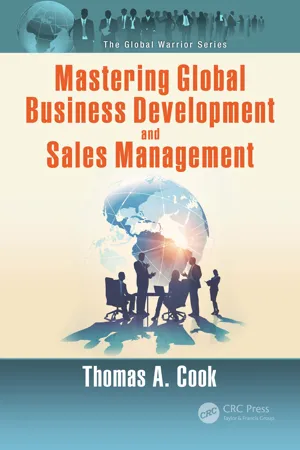Business Development
Business development involves activities and initiatives aimed at creating and implementing growth opportunities within an organization. This can include identifying new markets, forming strategic partnerships, and expanding product offerings. The goal of business development is to drive sustainable growth and profitability for the company.
6 Key excerpts on "Business Development"
- Margareta Nelke(Author)
- 2011(Publication Date)
- Chandos Publishing(Publisher)
...Business Development is carried out at an operational level and at that level the activity is about the continuous review and improvement of routines and current operations. At a strategic level, on the other hand, it is about the more general direction of the business in a longer time perspective. This requires detailed knowledge of stakeholders, their agenda, needs and wishes. It also requires the ability to interpret signals from the outside world and to see into the future: which driving forces will affect our operations, which consequences will they bring, how can we seize the opportunities that arise, and how do we counter the threats? This is a book about strategic Business Development, which is characterised by the following: It is led by a vision and a mission. It has a long-term perspective. It has long-term goals. It has an overall plan. It sets the direction for the business rather than producing concrete action plans. The purpose of strategic Business Development is to ensure that the business is delivering value and benefits for the parent organisation, that enough resources are available for operations, that they are used in the best way, and to ensure the long-term survival of the business. The work of strategic Business Development thus takes a longer perspective than the daily process of improvement. It is led by a vision and long-term goals. It is a continuous process aiming at both adapting and modifying activities to meet stakeholders’ current and future requirements, and at taking advantage of the opportunities that are offered today and that will be offered in the future. Strategic planning is needed to allocate limited resources to prioritised areas...
- Thomas A. Cook(Author)
- 2020(Publication Date)
- CRC Press(Publisher)
...1 The Importance of Business Development The importance of Business Development in both domestic and global business is that it assures sustainability. And simultaneously creates a track to growth and expansion. This chapter creates the foundation for companies to prioritize sales and Business Development management and practice. It is amazing to me how many companies do not have a structured and concerted effort in Business Development. It is rather a by-product of existing relationships, good customer service, or of reputation or of the persona of the organization. All those areas are good and important, but they fail in creating a pathway to long-term sustainability and expansion. Most of these types of companies will have stunted growth and, at some point, begin to lose market share. And even if the growth is good … the real questions are … how good could it be? Are we maximizing our opportunities? THE CRITICAL IMPORTANCE OF Business Development A company needs to continually grow and expand. I have heard it said by seasoned businessmen for over 35 years … if you are not growing … you’re dead! While I believe a company goes through cycles, where some cycles have “downturns” … I firmly embrace the idea that over a longer time frame, a company must be growing. Growth is a number of areas that are expected, as follows. GEOGRAPHICALLY A company is best when it diversifies its markets over the entire United States and the World...
- Martin Austin(Author)
- 2016(Publication Date)
- Routledge(Publisher)
...CHAPTER 1 The Role of Business Development Defining Business Development What is ‘Business Development’? This is usually the first question I have to answer whenever I’m asked what I do for a living by people outside the pharmaceutical industry. The answers I try to give are often tailored to the audience and what they are likely to quickly understand from their own experience. However, as few people have any idea that such a role exists beyond some hazy idea of marketing they usually smile politely and suddenly remember there is someone on the other side of the room to whom they must say hello immediately. So a definition of Business Development, at least as I have seen it performed since it comes in many different guises, will be useful. I define it as ‘any activity that alters the status quo of the business’. This includes activities such as: • planning • adding for growth • subtracting for profit • business process improvement • competitive awareness and advantage. Planning is a central activity to Business Development because, as a friend once told me, ‘There is no worse combination than great tactics and a lousy strategy – you just make things worse faster.’ In order to plan well, the business developer will need to have or obtain a number of skills and resources and these will be the subject of later chapters. However, a base set of skills for the business developer include being well organized, having a good breadth of knowledge, imagination, being good at analysis in different forms and having good communications skills, particularly listening and interpretation. Good organization means not just being able to collect information but to collate it, recall it and relate it. I have had the advantage of having worked briefly in IT with database designers and seen how the discipline of having a process for each of these activities creates a systematic approach. These processes can be made into a computer program...
- eBook - ePub
Effective Client Management in Professional Services
How to Build Successful Client Relationships
- Jack Berkovi(Author)
- 2016(Publication Date)
- Routledge(Publisher)
...Experience shows that in some professional service sectors there can be a potential 20 per cent ‘churn’ rate among the Client base. It can take up to 10 productive meetings over an 18-month period to win a new Client. This means that adopting a co-ordinated and sustained approach to Business Development is essential. The most enlightened firms have stimulated and developed a Business Development mind-set and collaboration across all Client-facing functions. Strategic marketing plans are prepared to attract these prospects and Clients through various tactical activities. The leads generated by these marketing activities are then followed up and qualified by Business Development people. Prior to a meeting with the prospect or the Client, many firms sets up an internal meeting to discuss their potential and agree a plan of action to convert the opportunity into business. The person responsible for Business Development then helps fee earners to retain and grow business with the Client. As mentioned in earlier chapters, the aim is to develop a portfolio of loyal Clients who consider the firm as its trusted adviser. As it is not possible to resource a Business Development programme to cover all of your existing Clients, it is important to have distinct programmes to grow existing Clients and to pursue new Clients. With existing Clients it’s best to focus on those that are most likely to yield the highest returns for the time invested. Some firms call these key or strategic Clients. Members of the Business Development team are expected to be well-versed in consultative selling which involves a detailed analysis of the prospective opportunity prior to contact and preparation of an agreed pursuit plan. A focused programme requires some form of strategic Client planning and a managed pipeline that shows the flow of opportunities from initial enquiry to conversion to business...
- Tim Ellis(Author)
- 2018(Publication Date)
- Routledge(Publisher)
...5 Business Development This chapter outlines the process of Business Development (BD), or outside selling. The previous chapter outlined the need for a ‘frontline’ of key personnel to create the brand as the consultant of choice. This chapter outlines the process for building meaningful client relationships based on trust. The following chapter describes the process for preparing a winning proposal. 5.1 Context An indicative portfolio of a large professional services firm is outlined in Table 5.1. As discussed in Chapter 3, balancing a consulting or projects firm highlights the diversity of the project portfolio and therefore the differing planning and managing activities required. On one hand, almost one-third of the firm’s profit can be earned by a small number of major projects. On the other hand, a portfolio of small projects ‘swim through’ the firm each year and need to be managed with little burden. The ‘swim lanes’ for each project type will require a different approach and this approach should be on a risk-based approach, as described later in the book. This means that the application of organisational management and project leadership needs to be adapted to the scale and complexity of the project, or portfolio of projects. And also the manner in which we pursue these opportunities, either by client or by project. Many professional firms use the same salary multiplier for selling their costs, irrespective of the different costs and risks of selling and managing. However, each project represents a different scale and complexity so the salary multiplier and therefore profitability should be different, recognising the risks and the client’s appreciation of the value we bring. Table 5.1 Indicative portfolio of projects by fee scale While we should diligently develop a bottom-up first principles estimate of the cost of delivering the services, we should always consider what the client is willing to pay, top-down...
- eBook - ePub
Virtual Business Models
Entrepreneurial Risks and Rewards
- Karin Bryder, Anki Malmborg-Hager, Eskil Söderlind(Authors)
- 2016(Publication Date)
- Woodhead Publishing(Publisher)
...Chapter 4 Business Development Abstract The Business Development team is a communicator of the Virtual Company’s business mainly externally but also internally. This team will ensure that the development is in correlation with the demands from the outside world and telling the world of the Virtual Company developments when appropriate. Defining the core asset of the company is important and will ensure that all Business Development activities are focused on the development of the company asset and the product. Choose the Business Development team carefully and it should include all competences used for the product development. Regularly scheduled meetings using virtual communication and face-to-face meetings are important in order to keep everyone focused on the right issues. A well-prepared Business Development plan will save time and money. The business plan is not a one-time effort but needs to be continuously updated on the basis of the progress of the company and to be used in the overall execution of the Business Development activities. Keywords Business Development; business plan; competitive intelligence Business Development Formal information flow in the nonvirtual company Business Development in the nonvirtual company is often a team effort where the key responsibility rests with the CEO or a VP Business Development executive. The overall objective for the Business Development team is to advance the business, an objective that includes marketing, sales, communication to external stakeholders, and the overall responsibility for relevant agreements. The detailed Business Development responsibilities might differ from company to company, depending on the nature of the business and also on how the work is divided between the CEO and the Business Development department. In the nonvirtual company, there is a formal structure where the different company functions interact and can formally report to the Business Development manager...





